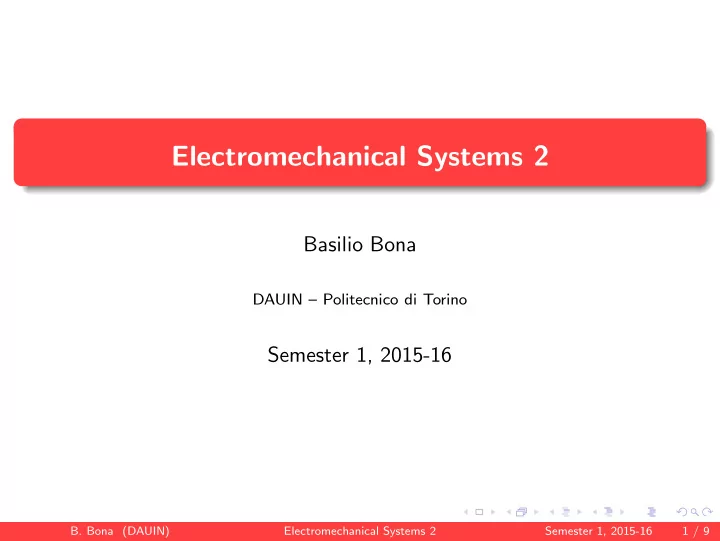

Electromechanical Systems 2 Basilio Bona DAUIN – Politecnico di Torino Semester 1, 2015-16 B. Bona (DAUIN) Electromechanical Systems 2 Semester 1, 2015-16 1 / 9
Electrostatic microphone An electrostatic or capacitive microphone is a sensing element that transduces incoming sound waves into electrical signals. It consists of an elastic membrane that moves one of the two plates of an electrostatic capacitor, the other plate being fixed. The electrical capacity varies according to the variation of the dielectric gap length. The sensing circuit is powered by a voltage generator E 0 with a resistance R . B. Bona (DAUIN) Electromechanical Systems 2 Semester 1, 2015-16 2 / 9
Electrostatic microphone B. Bona (DAUIN) Electromechanical Systems 2 Semester 1, 2015-16 3 / 9
Electrostatic microphone B. Bona (DAUIN) Electromechanical Systems 2 Semester 1, 2015-16 4 / 9
Electrostatic microphone The charge stored in the capacitor is q ( t ) = C ( x ( t )) e ( t ) Since in general C = ε r ε 0 S , if S is a constant we can write d Cd = ε r ε 0 S = constant, therefore x 0 C ( x )( x 0 + x ) = C 0 x 0 → C ( x ( t )) = C 0 x 0 + x ( t ) where x 0 is the nominal distance of the two plates at rest, and C 0 is the nominal capacity for x = x 0 . The plate has a mass m and during the interaction with the sound waves the x ( t ) distance varies. The elasticity of the structure and the viscous friction are taken into account respectively by the k and β parameters. B. Bona (DAUIN) Electromechanical Systems 2 Semester 1, 2015-16 5 / 9
Electrostatic microphone The constitutive relations are e ( t ) = e ( q ( t ) , x ( t )) f ( t ) = f ( q ( t ) , x ( t )) i ( t ) = ˙ q ( t ) v ( t ) = ˙ x ( t ) Since C ( x ) e ( t ) = q ( t ) and f ( q , x ) = − ∂ W c ( q , x ) we have ∂ x f ( q , x ) = − q 2 = − q 2 ( t ) e ( q , x ) = q ( t ) x 0 + x ( t ) d � 1 � C 0 x 0 2 d x C ( x ) 2 C 0 x 0 B. Bona (DAUIN) Electromechanical Systems 2 Semester 1, 2015-16 6 / 9
Energies, etc. Assuming inductive effects negligible, i.e., L = 0, we have: m = 1 q , x ) = 1 2 Li 2 = 0 x 2 K ∗ 2 m ˙ K ∗ e = W ∗ i ( ˙ P m = 1 P e = 1 2 q 2 ( t ) x 0 + x ( t ) 2 kx 2 C 0 x 0 D m = 1 D e = 1 x 2 q 2 2 β ˙ 2 R ˙ F m = F ( t ) F e = E 0 with ∂ P e 1 ∂ P e ∂ q = q ( t ) x 0 + x ( t ) ∂ x = q 2 ( t ) 2 C 0 x 0 C 0 x 0 B. Bona (DAUIN) Electromechanical Systems 2 Semester 1, 2015-16 7 / 9
Lagrange equation 1 Equation related to the mechanical part: m ¨ x ( t ) + β ˙ x ( t ) + kx ( t ) = F ( t ) + F ′ Notice that, since the charge-voltage relation is linear, the quantity F ′ = − q 2 ( t ) 2 C 0 x 0 coincides with f ( q , x ) = − ∂ W c ( q , x ) ∂ x and is in opposition of the external force F ( t ) B. Bona (DAUIN) Electromechanical Systems 2 Semester 1, 2015-16 8 / 9
Lagrange equation 2 Equation related to the electrical part: q ( t ) + e ′ ( t ) = E 0 R ˙ Similarly, the term e ′ ( t ) = q ( t ) x 0 + x ( t ) C 0 x 0 coincides with the voltage e ′ ( t ) = ∂ W c ( q , x ) ∂ q B. Bona (DAUIN) Electromechanical Systems 2 Semester 1, 2015-16 9 / 9
Recommend
More recommend